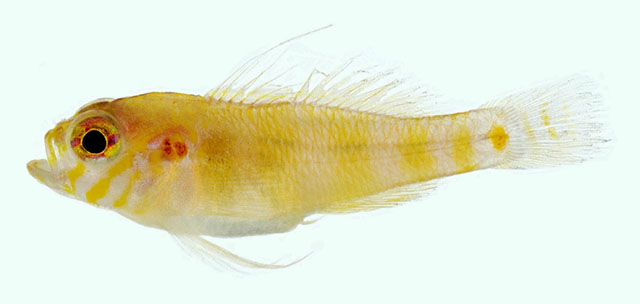| Gobiidae (Gobies), subfamily: Gobiinae |
| 1.7 cm SL (male/unsexed) |
|
reef-associated; marine; depth range 40 - 73 m |
| Western Pacific: Palau. |
|
Dorsal spines (total): -7; Dorsal soft rays (total): 10-11; Anal spines: -1; Anal soft rays: 9-10. This species is distinguished by the following set of characters: no scales on cheeks, opercle and nape; second spine of the first dorsal fin elongated, reaching posteriorly to the base of the 2nd-10th ray of the second dorsal fin when adpressed; pectoral-fin rays 17-18 with 12-13 branched rays in the middle of the fin; a single dichotomous branch point in the 5th pelvic-fin ray, its length 51-75% the length of the 4th ray; total gill rakers 17-18; beneath the eye 5 papillae in row c; midline between the base of the first dorsal spine and the posterior interorbital region is a very well developed dermal crest; a U-shaped interorbital trench with no fleshy median ridge; a poorly developed postorbital trench ending between the 4th to 5th papillae in row p (which has 6 papillae in total). Colouration when alive and freshly collected is very similar in appearance to T. sheppardi, body overall yellow with three yellow bars across the cheek, and a double dark spot above the posterior portion of the opercle (Ref. 122369). |
| Collected with quinaldine in a cave in a steep reef slope (Ref. 122369). |
|
Data deficient (DD); Date assessed: 07 September 2021 Ref. (130435)
|
| harmless |
Source and more info: www.fishbase.org. For personal, classroom, and other internal use only. Not for publication.

